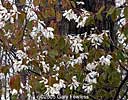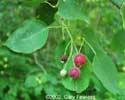
Trees of Wisconsin
| Amelanchier
laevis f. Michx. smooth serviceberry Family: Rosaceae |
||||||||||||
|
||||||||||||
|
Amelanchier laevis is similar to A. arborea in general appearance. The leaves are simple, alternate and regularly toothed and are often bronze in color, especially when young. They may be somewhat pubescent beneath when young, but become glabrous at maturity. The buds are relatively large (up to 10-12 mm) and long tapering to a sharp tip and each bud has more than 2 visible outer scales, often at least partly reddish. The plants may develop a single trunk, but they are almost always multiply-stemmed from the base, with well-developed plants reaching 20-30 feet in height or more, therefore appearing as a small tree or a very tall shrub. The bark is smooth and gray, and the trunks are often less than 10 cm in diameter. The flowers are showy with bright white petals opening in May or early June and producing numerous red or purple fleshy fruits. Individual plants are often easy to place in the genus, but the species can be difficult to distinguish in the absence of flowers. In fact they may be difficult even with the flowers and some individuals will appear to be intermediate, making identification very frustrating. Collectors are urged to take abundant samples and to record good field notes. There are also several other, more clearly shrubby species of Amelanchier in Wisconsin, and it is common to find two or more species in the same area. Hybridization has been widely reported, though it is less often supported convincingly beyond the presence of variable and confusing specimens. Our common Amelanchier species all appear to do best in sunny and dry sites, but they may persist as forest grows in around them and they are also found in smaller numbers in a wide variety of habitats, including wetter sites. Like Amelanchier arborea, Amelanchier laevis ranges widely in northeastern North America. In Wisconsin it is found throughout the state, but the true distribution and commonness is difficult to assess due to reluctance of botanists to collect (and keep) vouchers of these very challenging species. |
|






